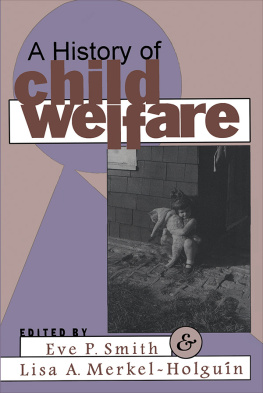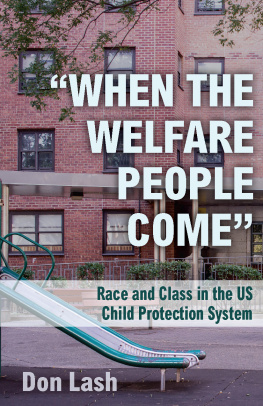Lisa Merkel-Holguin - A History of Child Welfare
Here you can read online Lisa Merkel-Holguin - A History of Child Welfare full text of the book (entire story) in english for free. Download pdf and epub, get meaning, cover and reviews about this ebook. year: 2017, publisher: Routledge, genre: Home and family. Description of the work, (preface) as well as reviews are available. Best literature library LitArk.com created for fans of good reading and offers a wide selection of genres:
Romance novel
Science fiction
Adventure
Detective
Science
History
Home and family
Prose
Art
Politics
Computer
Non-fiction
Religion
Business
Children
Humor
Choose a favorite category and find really read worthwhile books. Enjoy immersion in the world of imagination, feel the emotions of the characters or learn something new for yourself, make an fascinating discovery.
- Book:A History of Child Welfare
- Author:
- Publisher:Routledge
- Genre:
- Year:2017
- Rating:4 / 5
- Favourites:Add to favourites
- Your mark:
- 80
- 1
- 2
- 3
- 4
- 5
A History of Child Welfare: summary, description and annotation
We offer to read an annotation, description, summary or preface (depends on what the author of the book "A History of Child Welfare" wrote himself). If you haven't found the necessary information about the book — write in the comments, we will try to find it.
A History of Child Welfare — read online for free the complete book (whole text) full work
Below is the text of the book, divided by pages. System saving the place of the last page read, allows you to conveniently read the book "A History of Child Welfare" online for free, without having to search again every time where you left off. Put a bookmark, and you can go to the page where you finished reading at any time.
Font size:
Interval:
Bookmark:
- In Child Welfare in Fiction and Fact, Robert Bremner describes the portrayal of child welfare conditions in novels and stories of nineteenth century English and American literature, and points out that these stories reflect then-prevailing views regarding the child welfare system. Prominent was the idea that keeping children with their own families, or placing them in new families that would love and care for them, was best for the children.
- The movement against child labor brought new difficulties for family service workers in the first few decades of the twentieth century. Beverly Stadums chapter, The Dilemma in Saving Children from Child Labor, concerns the actions of children, families, and social workers who were caught up in the conflict between the economic pressures of families who needed childrens incomes and the implementation of new child labor policies.
- In The Child Welfare Response to Youth Violence and Homelessness, Kristine Nelson compares the economic conditions and social crises of the growing number of homeless children and the rates of violence of the 1850s to those of the 1980s. Nelson notes that both crises were consequences of laissez-faire economic policies.
- Despite research that almost always connects neglect with problems of poverty, society continues for the most part to blame mothers instead of working toward systemic change. In An Outrage to Common Decency, Karen Swift documents historical connections to present-day views of child neglect.
- William Tuttle, in Rosie the Riveter and Her Latchkey Children, describes the U.S. governments swiftness in moving to create and fund a system of child day care during the Second World War, as well as food programs for working mothers and their children. This demonstration proved that rapid program development and implementation for children and families is possible when the need of the nation is great enough.
- In Bring Back Orphanages? What Policymakers of Today Can Learn from the Past, Eve Smith describes the orphanages of the nineteenth and early twentieth centuries, and concludes that inherent difficulties would make it virtually impossibleor at best, extremely expensiveto recreate them. She also reminds us that even in the heyday of orphanages, many professionals criticized institutional living as not being in childrens best interests, and preferred family care.
- The social ethos that evolved during the nineteenth and early twentieth centuries led to the development of institutions by the African American community. Struggling against racism and segregation, African American women pursued the development of child welfare facilities for African American children. Wilma Peebles-Wilkins describes the nature of such developments with her chapter, Janie Porter Barrett and the Virginia Industrial School for Colored Girls.
- Turning to the subject of family foster care, Tun Hacsi, in From Indenture to Foster Care, affords an overview of the history of out-of-home care, stressing major societal changes that led to program changes. He shows how conflicting and difficult-to-reconcile goals and beliefs contribute to the current shape of government-funded care.
- Jeanne Cook, in A History of Placing-Out: The Orphan Trains, describes the program of the Childrens Aid Society, which sent approximately 150,000 children to homes in western states between 1853 and 1929. The Society deliberately removed children from the reach of parentsostensibly for the good of the children.
Font size:
Interval:
Bookmark:
Similar books «A History of Child Welfare»
Look at similar books to A History of Child Welfare. We have selected literature similar in name and meaning in the hope of providing readers with more options to find new, interesting, not yet read works.
Discussion, reviews of the book A History of Child Welfare and just readers' own opinions. Leave your comments, write what you think about the work, its meaning or the main characters. Specify what exactly you liked and what you didn't like, and why you think so.








